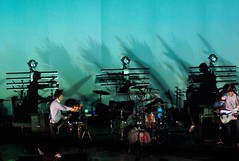
When I was in the Bay Area last week, I visited Howard Rheingold and went for walk with him and Pearl. (More photos: 1 | 2)
We were talking about meditation and other related activities. Howard recommended drawing as another relaxing and mind expanding activity. I told Howard that I had no talent and that drawing was one thing I would never be good at. Howard smirked and explained that there really wasn't much talent necessary for basic drawing and that he thought I would enjoy it.
I was skeptical but Howard gave me his copy of Drawing on the Artist Within by Betty Edwards from his library and I lugged the huge hardcover book onto the plane and read it. I was prepared to be surprised, but I was more surprised than I imagined I could be.
Betty Edwards starts out explaining that drawing is like reading and writing for the right hemisphere of the brain. The right brain deals with spacial and relationship oriented things and is good at dealing with chaos and complexity. She explains that people who are "not good at drawing" typically have strong left brain tendencies which often prevents the right brain from taking charge of drawing.
The right brain likes order and abstraction and parses everything you see into symbols. For instance, instead of seeing small person, medium sized person, large person, if the people are framed correctly, you will see person (far away), person (medium distance), person (close) and parse the different sizes as distances rather than three separate sized people. This is useful when you are trying to assess a visual image in a left brain sort of way. However, when you are trying to draw an image or notice differences or details, your left brain can get in the way.
When you are trying to draw a human figure, for instance, you will often draw a round head, eyes, hands, feet, etc. Each component will look like some abstraction of that part of the body. In fact, depending on the direction from which you are viewing that part of the body or person, the shape of each of those elements are infinitely different. When your left brain is in charge you label each element, for instance, "that's an eye" and draw what your left brain thinks of as an eye element instead of what you actually see. That's how people like me end up with child-like drawings.
She gives an example of an American flag hanging on the wall. The first week, her students draw things that looks like parallelograms with straight bars. The next week she tells them to notice that the bars cross each other in real life at angles. The students then draw a slightly more realistic flag with folds/waves. The next week she tells them to notice that the bars are different widths and the stars are each a different shape. This is paradoxical to the left brain since it is imagining the symbolic view of each element. In fact, when you look at a flag hanging on the wall and the image is flattened onto a 2D view like a drawing, all of the elements turn into different shapes.
She gives the reader a number of techniques to "trick" the left brain into letting go - drawing very fast, drawing very slow or drawing an image that is upside down. She presents exercises that show how easy it is to dramatically improve your drawing by just getting your left brain to let go so that your right brain can see things as they are and not abstracted.
The right brain is a very important partner in problem solving and thinking and your left brain and right brain already have a lot of back and forth. Your right brain deals with most of the complexity of driving while your left brain thinks of something else or remembers directions. Your left brain collects information and your right brain then "incubates" the idea tossing it back sometime in the future to your left brain as an "aha!"
Edwards hypothesizes convincingly that drawing is a great way to talk to your right brain and more directly bring your right brain into a "conversation" of conscious problem solving. I thought about drawing in the context of meditation which is also a lot about getting the left brain to "go away" or "shut up". Since reading the book on the plane, I have been scribbling sketches in my notebook. I continue to be surprised at this newly discovered ability that has been hidden for 40 years. Who said you can't teach an old dog new tricks?
I'm not sure yet whether I'm going to share any of my "artwork" with the public, but I am surely going to begin drawing as a way of thinking about things and spending time. I have a feeling that it will also help me communicate graphically and may even improve my sense of direction. ;-)
I'm REALLY excited about discovering a key to a door I shut way back in elementary school and I think this new hobby will work well in my "new lifestyle". If you've every thought, "I'm not good at drawing," I highly recommend and urge you read this book and reconsider. Also, if you recommend any other books or resources along these lines, I'd appreciate any pointers.
![Joi Ito [logo]](/_site/img/joi-ito-logo-300.png)














